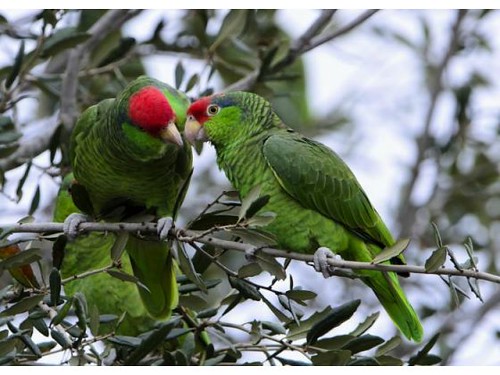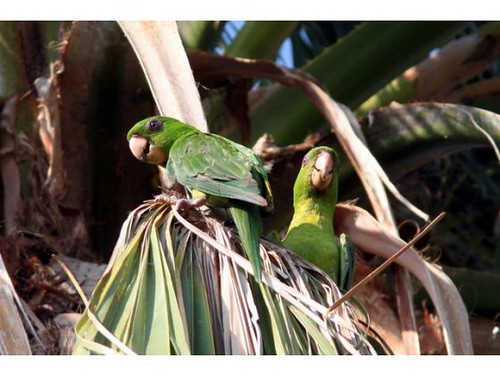Weslaco leadership group installs parrot micro-habitats
 Monday, July 9, 2012 at 23:38
Monday, July 9, 2012 at 23:38  Red-Crowned Parrots. Photo courtesy of Brian PlathWESLACO — In the northwest corner of Harlon Block Park, where most of the surrounding palm trees are small and young, a new tower of carefully wrapped dead palms stands tall.
Red-Crowned Parrots. Photo courtesy of Brian PlathWESLACO — In the northwest corner of Harlon Block Park, where most of the surrounding palm trees are small and young, a new tower of carefully wrapped dead palms stands tall.
Members of the Leadership Mid-Valley class are hoping the hollowed tree stalks will draw new life, as a home for Green Parakeets and Red-crowned Parrots.
“There were two of us in the group who were leaders in the birding industries, so we were particularly interested in doing something for the parrots,” said Sarah Williams, class participant and executive director of Frontera Audubon Society.
“The Red-crowned Parrot especially is considered endangered and it’s a really big draw for tourists that come into the area,” Williams said. “They come in oftentimes and ask me, ‘Where can I find the parrots?’”
This year’s nine members of the annual leadership course funded by the Weslaco Chamber of Commerce made a project of creating three different “micro-habitat” locations for the birds around the city. The population of parakeets and parrots, which either migrated north from Mexico or grew from released pets, has adapted to prefer urban homes, Williams said.
 Green parakeets Photo courtesy of Dan JonesThe group erected the Harlon Block location along West 18th Street last month with the help of American Electric Power and Magic Valley Electric, using a donated power pole to anchor the dead palms. Participants hope the hollow space will provide a spot for the birds to nest.
Green parakeets Photo courtesy of Dan JonesThe group erected the Harlon Block location along West 18th Street last month with the help of American Electric Power and Magic Valley Electric, using a donated power pole to anchor the dead palms. Participants hope the hollow space will provide a spot for the birds to nest.
“If you look around (Harlon Block) you can see that there are a lot of younger trees because it’s a new park,” said Kyle O’Haver, natural resource specialist for Estero Llano Grande State Park. “I see the parrots flying through this area, but they hardly ever land.”
Soon the group will install tree slab nesting boxes into locations at Frontera Audubon, 1101 S. Texas Blvd., and the Valley Nature Center, 301 S. Border Ave.
The sites aim to attract the colorful parrots and parakeets, but there’s no guarantee.
“We’re trying to put them in prime locations and at heights for parakeets, but that doesn’t mean you (won’t) see an owl in it one day, or a whistling duck,” O’Haver said.
Williams encouraged members of the public to contact Estero Llano Grande State Park for advice on how to create their own nesting areas for the birds.
The group hopes to draw attention to the Red-crowned Parrots in particular. The International Union for the Conservation of Nature lists the birds as endangered, but they are not protected by the Migratory Bird Treaty Act because they are considered nonnative, according to the U.S. Fish and Wildlife Migratory Bird Program.
Weslaco and several other Rio Grande Valley cities have local ordinances prohibiting people from injuring or capturing the birds or disturbing their nesting sites.
“They’re not protected other than by city code, because this is the only area in the country where they are considered wild,” O’Haver said.

